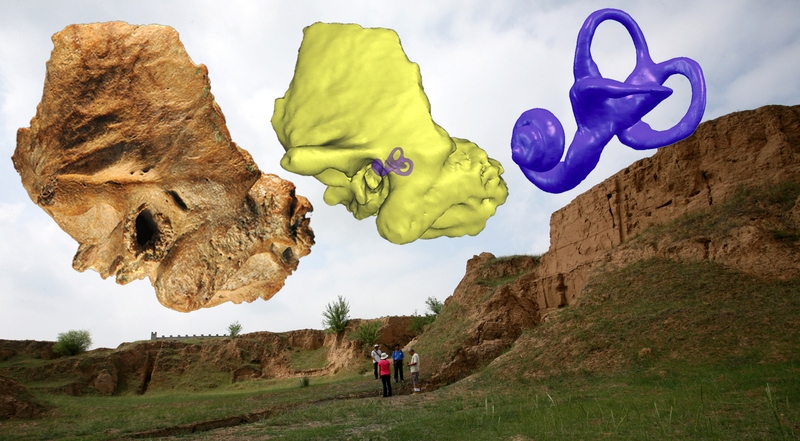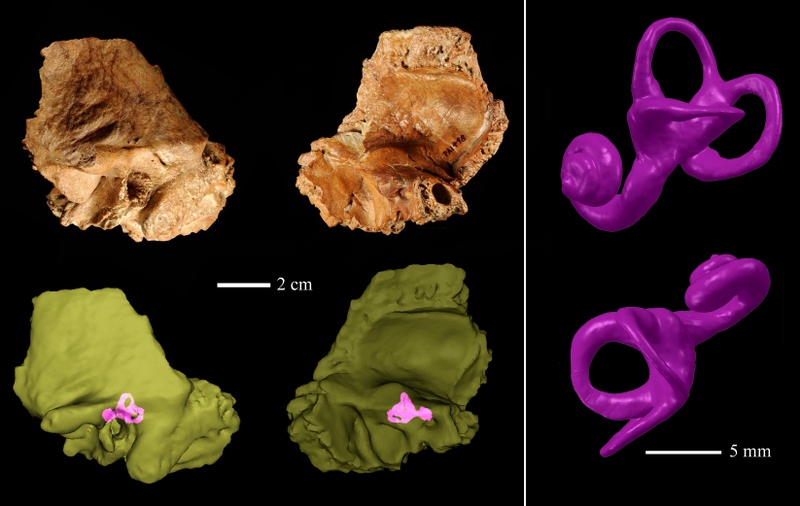
Once again, scientists examining an ancient human fossil are finding that the path of human evolution, at least over the last 100,000 years, is not as simple as evolutionists have thought.
In a recent study, researchers Xiu-Jie Wu, Wu Liu and Song Xing of the Institute of Vertebrate Paleontology and Paleoanthropology, Beijing, Isabelle Crevecoeur of PACEA, Université de Bordeaux, France, and Erik Trinkaus of Washington University in St. Louis, re-examined a circa 100,000-year-old archaic human skull originally found during excavations 35 years ago at the Xujiayao site in China’s Nihewan Basin. Based on their micro-CT scans of the interior configuration of the temporal bone, they found that the inner-ear formation closely resembled a formation long thought to occur only in Neanderthals.
“We were completely surprised,” Trinkaus said. “We fully expected the scan to reveal a temporal labyrinth that looked much like a modern human one, but what we saw was clearly typical of a Neandertal. This discovery places into question whether this arrangement of the semicircular canals is truly unique to the Neandertals.” Moreover, he said, “the discovery places into question a whole suite of scenarios of later Pleistocene human population dispersals and interconnections based on tracing isolated anatomical or genetic features in fragmentary fossils. It suggests, instead, that the later phases of human evolution were more of a labyrinth of biology and peoples than simple lines on maps would suggest.”
_________________________________________
 The Xujiayao 15 late archaic human temporal bone from northern China, with the extracted temporal labyrinth, superimposed on a view of the Xujiayao site. Credit: Institute of Vertebrate Paleontology and Paleoanthropology, Chinese Academy of Science
The Xujiayao 15 late archaic human temporal bone from northern China, with the extracted temporal labyrinth, superimposed on a view of the Xujiayao site. Credit: Institute of Vertebrate Paleontology and Paleoanthropology, Chinese Academy of Science
________________________________________
 The Xujiayao 15 temporal bone, with the extracted temporal labyrinth and its position in the temporal bone. Credit: Institute of Vertebrate Paleontology and Paleoanthropology, Chinese Academy of Science
The Xujiayao 15 temporal bone, with the extracted temporal labyrinth and its position in the temporal bone. Credit: Institute of Vertebrate Paleontology and Paleoanthropology, Chinese Academy of Science
_______________________________________
Often well-preserved in mammal skull fossils, the semicircular canals are remnants of a fluid-filled sensing system that helps humans maintain balance when they change their spatial orientations, such as when running, bending over or turning the head from side-to-side.
Since the mid-1990s, when early CT-scan research confirmed its existence, the presence of a particular arrangement of the semicircular canals in the temporal labyrinth has been considered enough to securely identify fossilized skull fragments as being from a Neanderthal. This pattern is present in almost all of the known Neanderthal labyrinths. It has been widely used as a marker to set them apart from both earlier and modern humans.
The skull at the center of this study, known as Xujiayao 15, was found along with an assortment of other human teeth and bone fragments, all of which seemed to have characteristics typical of an early non-Neanderthal form of late archaic humans.
Trinkaus, who has studied Neanderthal and early human fossils from around the globe, said this discovery only adds to the rich confusion of theories that attempt to explain human origins, migrations patterns and possible interbreedings.
“The study of human evolution has always been messy, and these findings just make it all the messier,” Trinkaus said. “It shows that human populations in the real world don’t act in nice simple patterns.”
Research details are published in the Proceedings of the National Academy of Sciences.
___________________________________________
Source: Adapted and edited from a Washington University in St. Louis press release, Discovery of Neandertal trait in ancient skull raises new questions about human evolution.
___________________________________________
Read about the most fascinating discoveries with a premium subscription to Popular Archaeology Magazine. Find out what Popular Archaeology Magazine is all about. AND MORE:
On the go? Purchase the mobile version of a recent issue of Popular Archaeology Magazine here for only $2.99.
Popular Archaeology’s annual Discovery Edition eBook is a selection of the best stories published in Popular Archaeology Magazine in past issues, with an emphasis on some of the most significant, groundbreaking, or fascinating discoveries in the fields of archaeology and paleoanthropology and related fields. At least some of the articles have been updated or revised specifically for the Discovery edition. We can confidently say that there is no other single issue of an archaeology-related magazine, paper print or online, that contains as much major feature article content as this one. The latest issue, volume 2, has just been released. Go to the Discovery edition page for more information.





